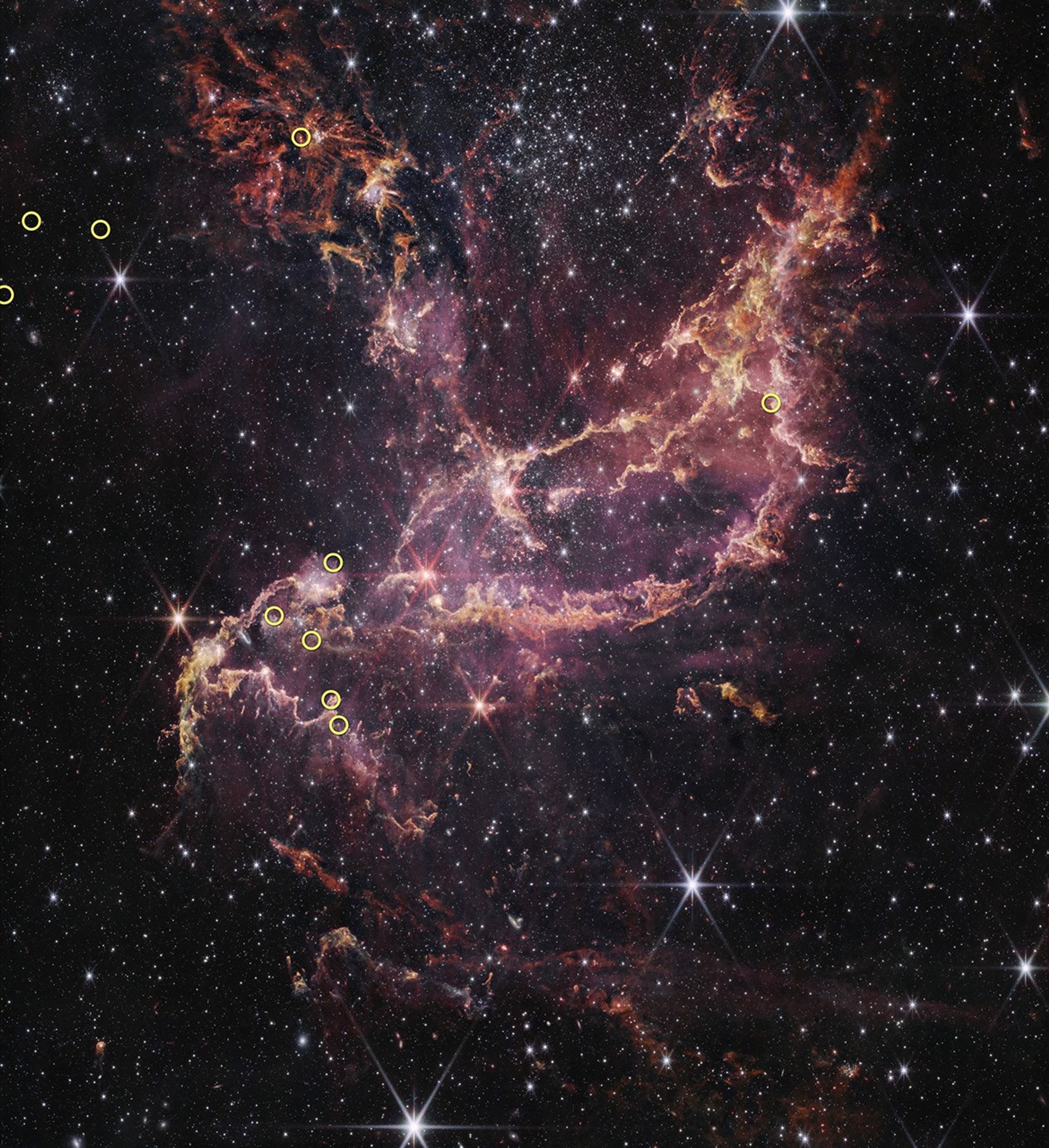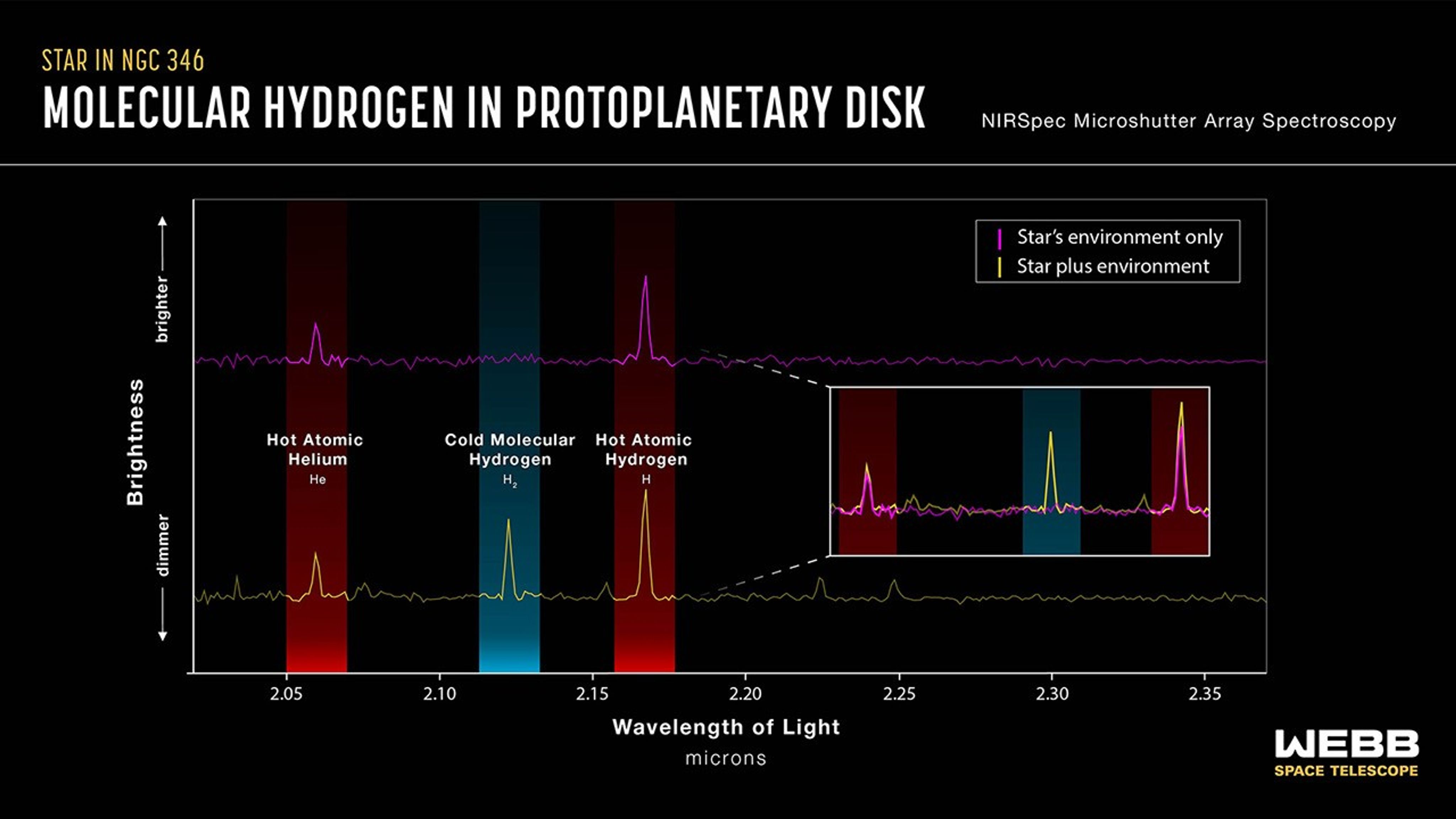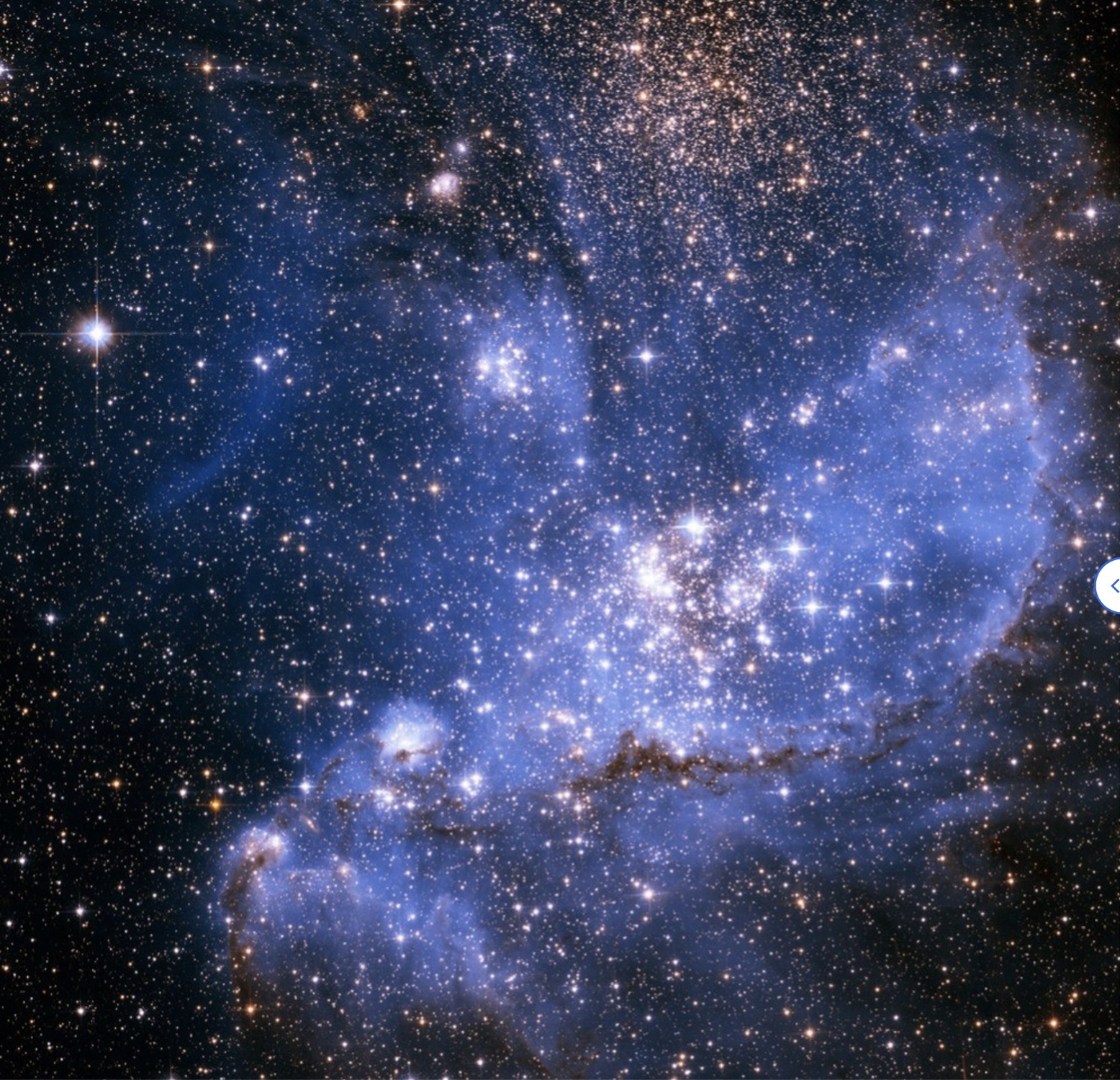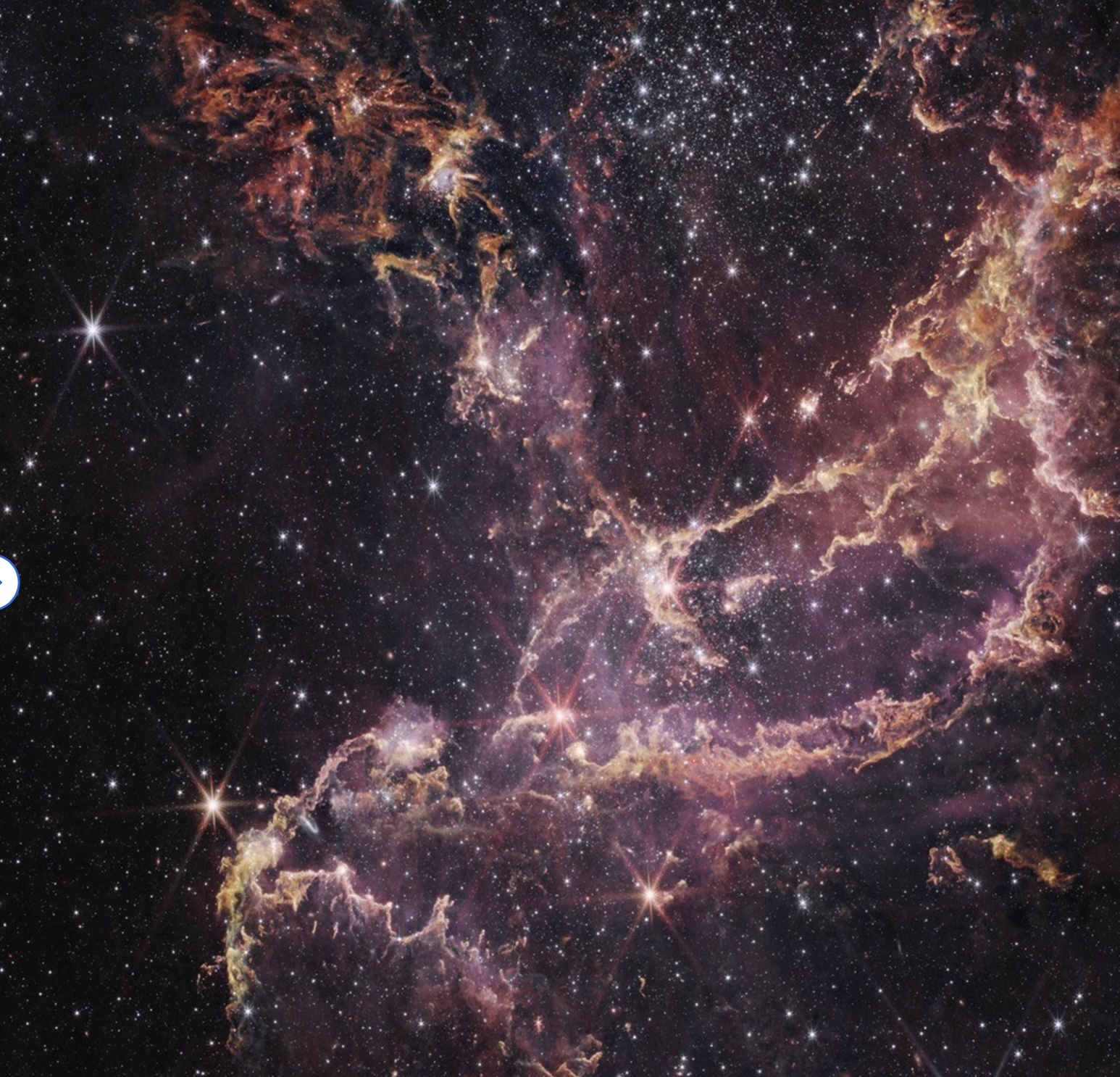"The Spiderweb protocluster is an ideal laboratory for investigating the relationship between black holes and star formation in detail."
NASA's James Webb Space Telescope found evidence that supermassive black holes suppress star formation in maturing galaxies.
The team used the James Webb Space Telescope's (JWST) Near Infrared Camera (NIRCam), analyzed 19 galaxies that are part of the Spiderweb protocluster, one of the best studied galaxy groups in the universe, which lies some 11 billion light-years away from Earth.
They found that galaxies that appear to have supermassive black holes at their hearts produce stars at a much slower rate than those without such black holes. The findings might help fill a long-standing gap in our understanding of galaxy evolution.
"We succeeded in obtaining high-resolution maps of the recombination lines of hydrogen, which indicate the activity of star formation," Rhythm Shimakawa, an associate professor of astronomy at Waseda University in Japan and lead author of the study, told Space.com. "We found that massive galaxies with active supermassive black holes exhibit no sign of star formation when compared to those without active supermassive black holes."
Stars form when massive clouds of cold hydrogen gas collapse under the weight of their gravity. As the density of matter inside the collapsing cloud increases, its temperature soars. That ultimately triggers nuclear fusion, which brings the stars to life.
This process causes the ionization of hydrogen atoms, a mechanism that emits a specific type of radiation visible in the light spectra obtained by sophisticated instruments such as the JWST's NIRCam.
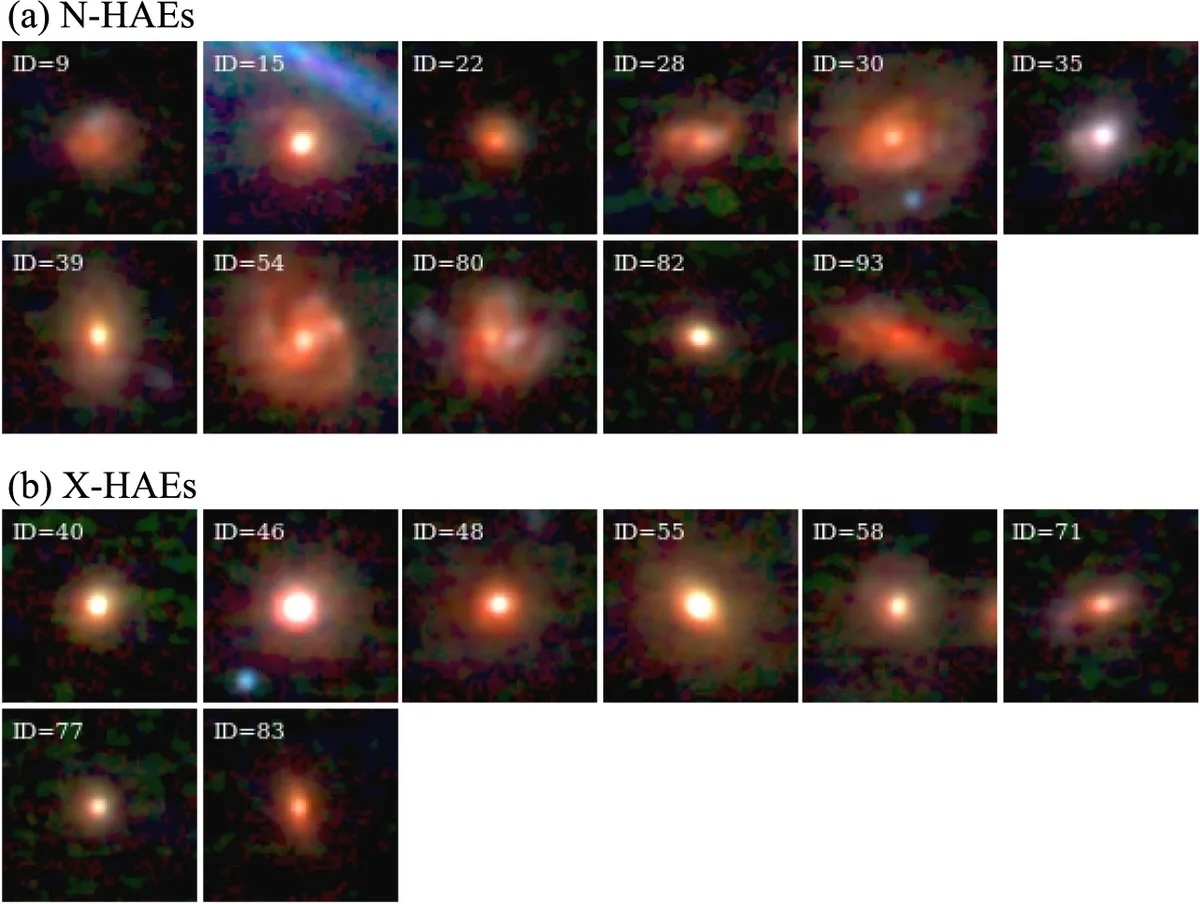
Researchers compared eight galaxies with active supermassive black holes and 11 galaxies with smaller black holes. (Image credit: Shimakawa et al.)
Scientists have long observed that the older galaxies get, the fewer stars they appear to produce. Originally, experts thought that star formation slows down simply because galaxies use up their cold hydrogen gas. However, observations have revealed that some galaxies as young as 1 billion years (our Milky Waygalaxy is 13.6 billion years old, for context) already show signs of a star-formation burnout. That is too short a period to allow those galaxies to run out of hydrogen gas through star formation alone.
Some astronomers have therefore suggested that, as galaxies grow by merging with other galaxies, the black holes at their centers grow as well, reaching millions of solar masses. (One solar mass is equal to one mass of our sun). As the black holes grow, their ability to suck out gas out of the galaxies would increase. The more massive the black hole, the faster the object makes matter spiral beyond its event horizon, reaching speeds of tens of thousands of miles per second. Some of these black holes spit out some of the accreting gas into intergalactic space in the form of relativistic jets, further stripping the galaxy of the star-bearing medium. The JWST observations of the Spiderweb protocluster, which, due to its vast distance appears to us as it looked less than 3 billion years after the Big Bang, support this theory.
"The Spiderweb protocluster is the first ancient galaxy cluster ever found and has been studied by various research groups for over two decades," Shimakawa said. "There are many massive galaxies [in the Spiderweb supercluster] hosting super massive black holes, which makes it an ideal laboratory for investigating the relationship between black holes and star formation in detail."
Star formation is usually nearly non-existent in large elliptical galaxies, which represent the final stage in galaxy evolution. Unlike spiral galaxies like the Milky Way, with their distinct structures of winding spiral arms, elliptical galaxies are rather shapeless. Scientists think these enormous accumulations of stars rose from smash-ups between younger galaxies. The force of these galactic collisions would've wiped out the neat structures of those predecessor galaxies, turning elliptical galaxies into chaotic regions where stars orbit in random directions. These smash-ups would also have merged the central black holes of the parent galaxies, producing a more massive black hole with each subsequent collision. As a result, the supermassive black holes at the centers of elliptical galaxies are the most massive known black holes.
As matter spirals toward such a supermassive black hole, it emits powerful X-rays that can be observed by other orbiting observatories such as NASA's Chandra X-ray Observatory. By comparing Chandra's observations with the JWST's measurements of hydrogen ionization, the researchers found that galaxies with the most ravenous black holes show the lowest star formation rates.
Scientists have previously seen evidence that supermassive black holes may push gas out of galaxies, but observations of the Spiderweb protocluster are particularly valuable as they reveal a pattern across a larger group of galaxies that are all roughly the same age. Eight of the observed galaxies have active supermassive black holes at their centers while 11 have quieter hearts.
Shimakawa, however, says that not enough is known about the interplay between supermassive black holes and their surrounding galaxies and that other mechanisms could be contributing to the slowing star formation.
The study was published on Dec. 18 in the journal Monthly Notices of the Royal Astronomical Society.
Quelle: SC
----
Update: 16.01.2025
.
Newfound Galaxy Class May Indicate Early Black Hole Growth, Webb Finds
n December 2022, less than six months after commencing science operations, NASA’s James Webb Space Telescope revealed something never seen before: numerous red objects that appear small on the sky, which scientists soon called “little red dots” (LRDs). Though these dots are quite abundant, researchers are perplexed by their nature, the reason for their unique colors, and what they convey about the early universe.
A team of astronomers recently compiled one of the largest samples of LRDs to date, nearly all of which existed during the first 1.5 billion years after the big bang. They found that a large fraction of the LRDs in their sample showed signs of containing growing supermassive black holes.
“We’re confounded by this new population of objects that Webb has found. We don’t see analogs of them at lower redshifts, which is why we haven’t seen them prior to Webb,” said Dale Kocevski of Colby College in Waterville, Maine, and lead author of the study. “There's a substantial amount of work being done to try to determine the nature of these little red dots and whether their light is dominated by accreting black holes.”
Image A: Little Red Dots (NIRCam Image)
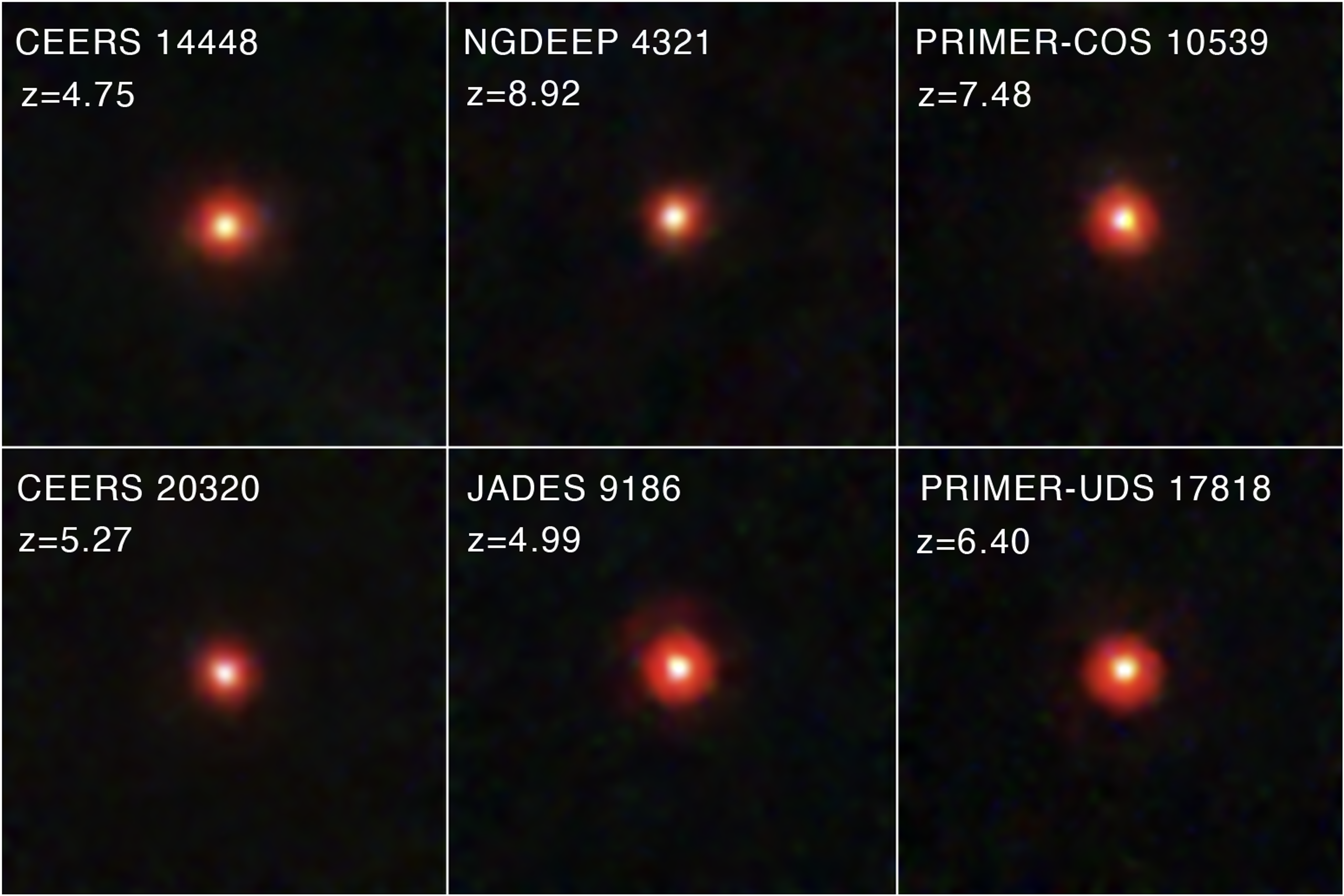
A team of astronomers sifted through James Webb Space Telescope data from multiple surveys to compile one of the largest samples of “little red dots” to date. From their sample, they found that these mysterious red objects that appear small on the sky emerge in large numbers around 600 million years after the big bang and undergo a rapid decline in quantity around 1.5 billion years after the big bang.
NASA, ESA, CSA, STScI, Dale Kocevski (Colby College)
A Potential Peek Into Early Black Hole Growth
The methodology used to identify these objects also differed from previous studies, resulting in the census spanning a wide redshift range. The distribution they discovered is intriguing: LRDs emerge in large numbers around 600 million years after the big bang and undergo a rapid decline in quantity around 1.5 billion years after the big bang.
The team looked toward the Red Unknowns: Bright Infrared Extragalactic Survey (RUBIES) for spectroscopic data on some of the LRDs in their sample. They found that about 70 percent of the targets showed evidence for gas rapidly orbiting 2 million miles per hour (1,000 kilometers per second) – a sign of an accretion disk around a supermassive black hole. This suggests that many LRDs are accreting black holes, also known as active galactic nuclei (AGN).
“The most exciting thing for me is the redshift distributions. These really red, high-redshift sources basically stop existing at a certain point after the big bang,” said Steven Finkelstein, a co-author of the study at the University of Texas at Austin. “If they are growing black holes, and we think at least 70 percent of them are, this hints at an era of obscured black hole growth in the early universe.”
Contrary to Headlines, Cosmology Isn’t Broken
When LRDs were first discovered, some suggested that cosmology was “broken.” If all of the light coming from these objects was from stars, it implied that some galaxies had grown so big, so fast, that theories could not account for them.
The team’s research supports the argument that much of the light coming from these objects is from accreting black holes and not from stars. Fewer stars means smaller, more lightweight galaxies that can be understood by existing theories.
“This is how you solve the universe-breaking problem,” said Anthony Taylor, a co-author of the study at the University of Texas at Austin.
There is still a lot up for debate as LRDs seem to evoke even more questions. For example, it is still an open question as to why LRDs do not appear at lower redshifts. One possible answer is inside-out growth: As star formation within a galaxy expands outward from the nucleus, less gas is being deposited by supernovas near the accreting black hole, and it becomes less obscured. In this case, the black hole sheds its gas cocoon, becomes bluer and less red, and loses its LRD status.
Additionally, LRDs are not bright in X-ray light, which contrasts with most black holes at lower redshifts. However, astronomers know that at certain gas densities, X-ray photons can become trapped, reducing the amount of X-ray emission. Therefore, this quality of LRDs could support the theory that these are heavily obscured black holes.
The team is taking multiple approaches to understand the nature of LRDs, including examining the mid-infrared properties of their sample, and looking broadly for accreting black holes to see how many fit LRD criteria. Obtaining deeper spectroscopy and select follow-up observations will also be beneficial for solving this currently “open case” about LRDs.
“There’s always two or more potential ways to explain the confounding properties of little red dots,” said Kocevski. “It’s a continuous exchange between models and observations, finding a balance between what aligns well between the two and what conflicts.”
These results were presented in a press conference at the 245th meeting of the American Astronomical Society in National Harbor, Maryland, and have been submitted for publication in The Astrophysical Journal.
Quelle: NASA
----
Update: 15.02.2025
.
Webb Maps Full Picture of How Phoenix Galaxy Cluster Forms Stars
Discovery proves decades-old theory of galaxy feeding cycle.
Researchers using NASA’s James Webb Space Telescope have finally solved the mystery of how a massive galaxy cluster is forming stars at such a high rate. The confirmation from Webb builds on more than a decade of studies using NASA’s Chandra X-ray Observatory and Hubble Space Telescope, as well as several ground-based observatories.
The Phoenix cluster, a grouping of galaxies bound together by gravity 5.8 billion light-years from Earth, has been a target of interest for astronomers due to a few unique properties. In particular, ones that are surprising: a suspected extreme cooling of gas and a furious star formation rate despite a roughly 10 billion solar mass supermassive black hole at its core. In other observed galaxy clusters, the central supermassive black hole powers energetic particles and radiation that prevents gas from cooling enough to form stars. Researchers have been studying gas flows within this cluster to try to understand how it is driving such extreme star formation.
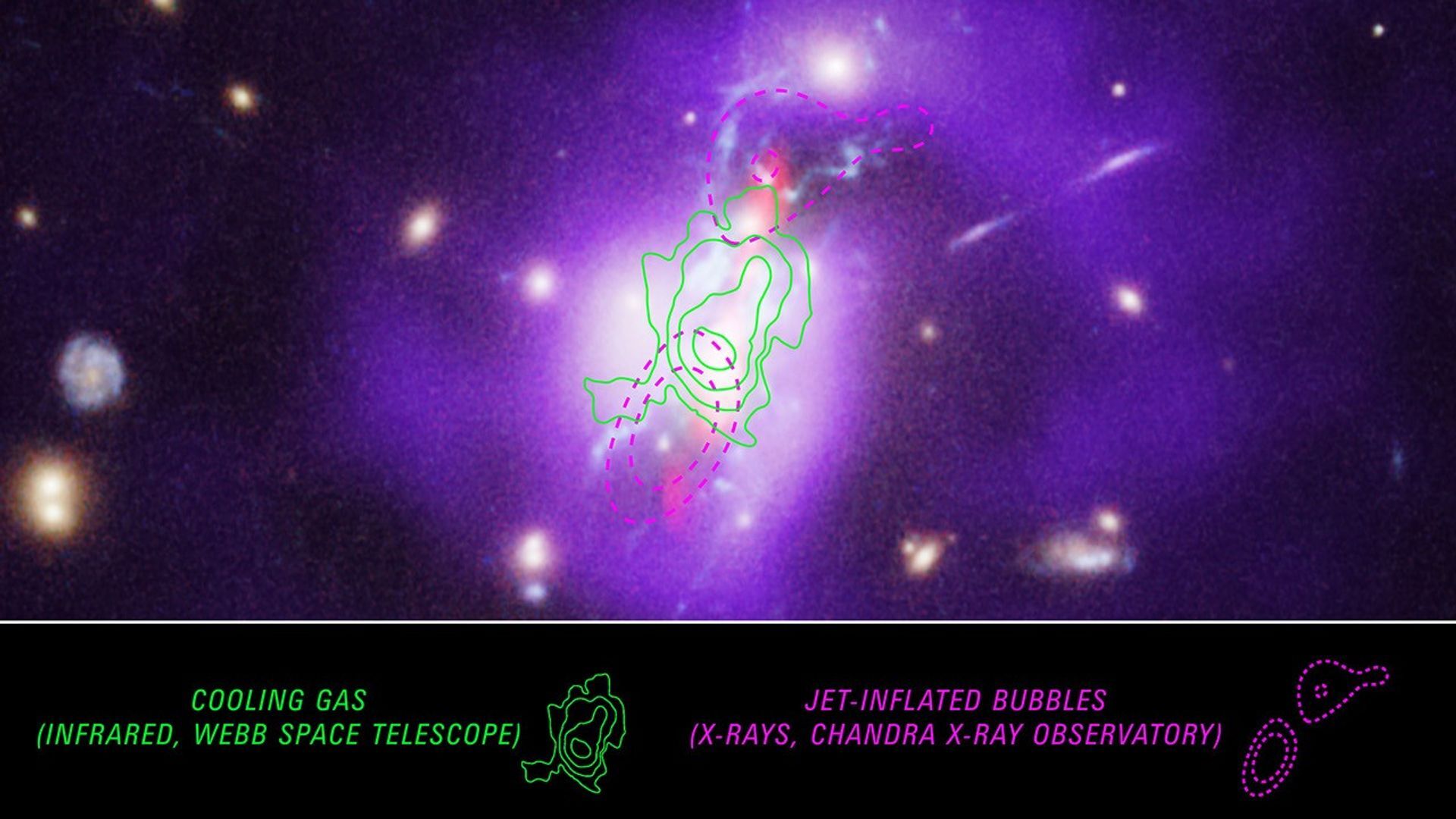
Spectroscopic data collected from NASA’s James Webb Space Telescope is overlayed on an image of the Phoenix cluster that combines data from NASA’s Hubble Space Telescope, Chandra X-ray Observatory and the Very Large Array (VLA) radio telescope. Webb’s powerful sensitivity in the mid-infrared detected the cooling gas that leads to a furious rate of star formation in this massive galaxy cluster.
Credit: NASA, CXC, NRAO, ESA, M. McDonald (MIT), M. Reefe (MIT), J. Olmsted (STScI)
“We can compare our previous studies of the Phoenix cluster, which found differing cooling rates at different temperatures, to a ski slope,” said Michael McDonald of the Massachusetts Institute of Technology in Cambridge, principal investigator of the program. “The Phoenix cluster has the largest reservoir of hot, cooling gas of any galaxy cluster — analogous to having the busiest chair lift, bringing the most skiers to the top of the mountain. However, not all of those skiers were making it down the mountain, meaning not all the gas was cooling to low temperatures. If you had a ski slope where there were significantly more people getting off the ski lift at the top than were arriving at the bottom, that would be a problem!”
To date, in the Phoenix cluster, the numbers weren’t adding up, and researchers were missing a piece of the process. Webb has now found those proverbial skiers at the middle of the mountain, in that it has tracked and mapped the missing cooling gas that will ultimately feed star formation. Most importantly, this intermediary warm gas was found within cavities tracing the very hot gas, a searing 18 million degrees Fahrenheit, and the already cooled gas around 18,000 degrees Fahrenheit.
The team studied the cluster’s core in more detail than ever before with the Medium-Resolution Spectrometer on Webb’s Mid-Infrared Instrument (MIRI). This tool allows researchers to take two-dimenstional spectroscopic data from a region of the sky, during one set of observations.
“Previous studies only measured gas at the extreme cold and hot ends of the temperature distribution throughout the center of the cluster,” added McDonald. “We were limited — it was not possible to detect the ‘warm’ gas that we were looking for. With Webb, we could do this for the first time.”
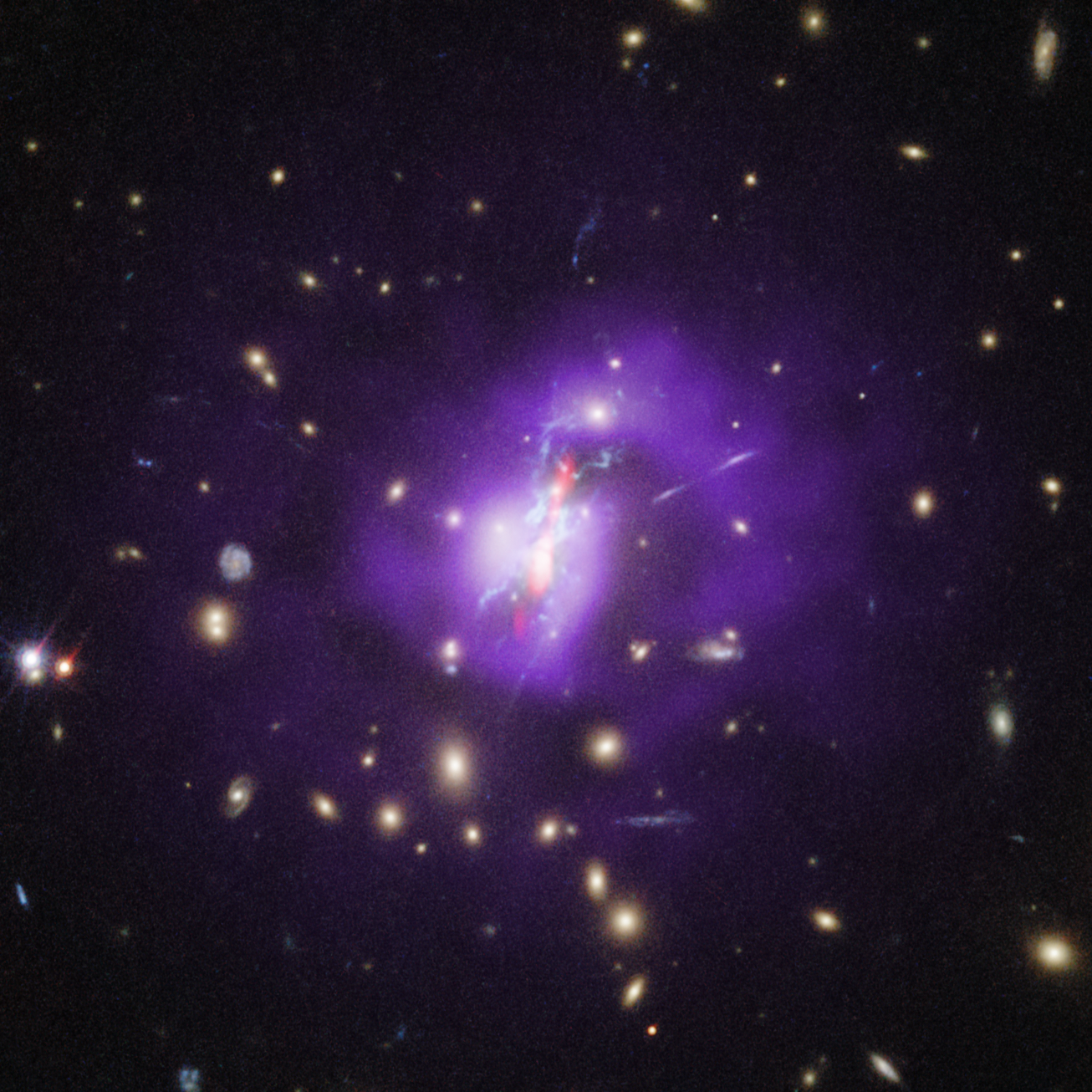
This image of the Phoenix cluster combines data from NASA’s Hubble Space Telescope, Chandra X-ray Observatory, and the Very Large Array radio telescope. X-rays from Chandra depict extremely hot gas in purple. Optical light data from Hubble show galaxies in yellow, and filaments of cooler gas where stars are forming in light blue. Outburst generated jets, represented in red, are seen in radio waves by the VLA radio telescope.
NASA, CXC, NRAO, ESA, M. McDonald (MIT).
Webb’s capability to detect this specific temperature of cooling gas, around 540,000 degrees Fahrenheit, is in part due to its instrumental capabilities. However, the researchers are getting a little help from nature, as well.
This oddity involves two very different ionized atoms, neon and oxygen, created in similar environments. At these temperatures, the emission from oxygen is 100 times brighter but is only visible in ultraviolet. Even though the neon is much fainter, it glows in the infrared, which allowed the researchers to take advantage of Webb’s advanced instruments.
“In the mid-infrared wavelengths detected by Webb, the neon VI signature was absolutely booming,” explained Michael Reefe, also of the Massachusetts Institute of Technology, lead author on the paper published in Nature. “Even though this emission is usually more difficult to detect, Webb’s sensitivity in the mid-infrared cuts through all of the noise.”
The team now hopes to employ this technique to study more typical galaxy clusters. While the Phoenix cluster is unique in many ways, this proof of concept is an important step towards learning about how other galaxy clusters form stars.The James Webb Space Telescope is the world’s premier space science observatory. Webb is solving mysteries in our solar system, looking beyond to distant worlds around other stars, and probing the mysterious structures and origins of our universe and our place in it. Webb is an international program led by NASA with its partners, ESA (European Space Agency) and CSA (Canadian Space Agency).
Quelle: NASA
